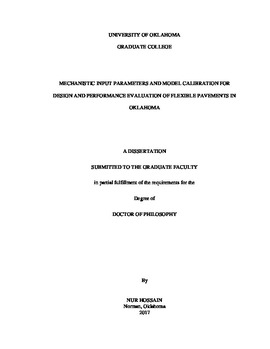| dc.description.abstract | The Mechanistic-Empirical Pavement Design Guide (MEPDG) – a product of research and experience involving more than 20 years of traffic, climate and materials data from different regions in the U.S. – has elevated pavement designs to a new level. The MEPDG has three different input categories: (1) traffic, (2) climate and (3) materials. It also has three different levels of input data: Level 1 (highest accuracy), Level 2 (medium accuracy) and Level 3 (default values/lowest accuracy). Lack of materials, climate, and traffic data and absence of locally calibrated distress models have been a major problem in the implementation of MEPDG by the state Departments of Transportation. This study was undertaken to enhance implementation of MEPDG in Oklahoma through collection of site specific materials and traffic data and local calibration of rut models.
A 1,000 ft. long instrumented test section was constructed on Interstate-35 near Purcell, Oklahoma. The test section consisted of five layers: two Hot Mix Asphalt (HMA), one aggregate base, one stabilized subgrade, and natural subgrade. MEPDG input parameters for traffic, climate and materials were developed from this test section’s data. The site included a weigh-in-motion (WIM) station and lateral positioning sensors to obtain input parameters for traffic. In addition, laboratory tests, namely Dynamic Modulus, Resilient Modulus, Dynamic Shear Rheometer and other pertinent tests were conducted using materials obtained from this test section. Rutting, fatigue cracking, and International Roughness Index (IRI) were measured at the test section for six years at three months interval. Minimal cracking and significant rutting were observed at the test section. The highest recorded rut value was 0.868 in. Cores were extracted from the cracked pavement locations, which revealed that the cracks were located primarily in the surface layer.
Differences in traffic input parameters between Level 3 (default) and Level 1 (site specific) were identified and discussed in this study. In addition, sensitivity and contribution of these input parameters to pavement designs are discussed. Since, developing Level 1 traffic inputs requires significant time and resources, the parametric study was focused on identifying the most sensitive traffic input parameters for pavement design. The Axle Load Spectra was found to be the most sensitive traffic input parameter, followed by Vehicle Class Distribution factors and Monthly Adjustment factors.
Significant errors (more than 30%) were observed when rut was predicted using Level 3 inputs. Although the average error was reduced to approximately 10% by using the Level 1 inputs, differences still existed, which necessitated the development of local calibration factors. Two approaches were used for this purpose: total rut and layer-wise rut. The calibration process using the total rut approach reduced the average error to less than 5%. The optimized calibration coefficients were found to be: β_r1 = 2, β_r2= 1, β_r3= 0.93 for asphalt layers; β_GB= 1 for aggregate base layer, and β_SG= 0.5 for natural subgrade layer.
At the end of field performance monitoring, forensic investigation was conducted to investigate the contribution of different pavement layers to rut. It was observed that the rut was contributed mostly by the HMA layers, more specifically by the surface layer. Since, negligible rut was found in the aggregate base and subgrade layers, the rut model coefficients were recalibrated using layer-wise approach. The optimized calibration coefficients were: β_r1 = 1.25, β_r2 = 1, β_r3 = 1.05 for HMA; β_GB = 0.05 for aggregate base, and β_SG = 0.05 for natural subgrade layers.
The database for Level 1 pavement design as well as the local calibration coefficients of the MEPDG rut models developed in this study are expected to enhance implementation of the MEPDG in Oklahoma. Also, the results from this study are expected to assist pavement designers in addressing rut problems in future design. | en_US |
